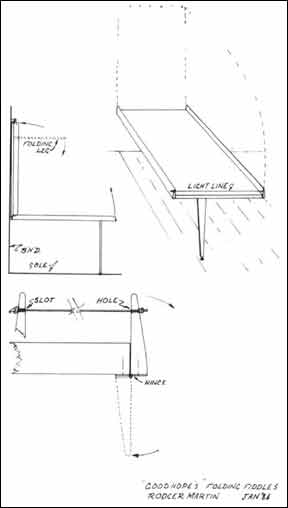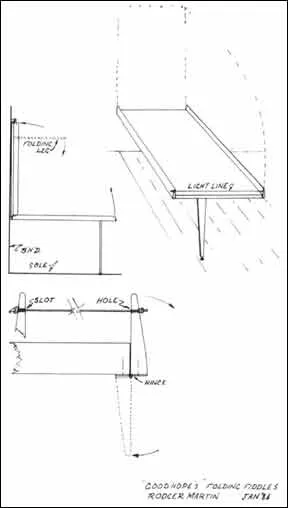In a rare instance of getting to have your cake and eat it too, this design for folding fiddles affords sturdy permanent fiddles suited to the typical folding cabin table found on boats under 35′, while avoiding some drawbacks of many fiddle arrangements. It has the advantage that the fiddles are always attached to the table; they do not have to be removed when the table is folded up against the bulkhead. In addition, the fiddles can be folded out of the way when the table is in use, making the table more useful for dining in harbor, when the protection of fiddles isn’t usually necessary.

288
We used this system on our 29′ sloop “Good Hope” during a year’s cruise. Because of the size of our boat, the table had to be used as a writing desk, drawing board, and card table, as well as for eating.
The forward end of the table uses a metal rod as a hinge. The metal rod is longer than the width of the table, so that the table may be slid inboard in use, making it easily accessible from both main cabin settees without the need for an extension. When folded against the bulkhead, it slides outboard, giving full access to the forward cabin.
The fiddles should be made of the same wood as the cabin table, if the table is wood, or the same wood as the interior trim of the boat, if the table is mica-topped plywood. They should extend 1 1/2 “to 2” above the surface of the table, so the total height will be the thickness of the table top, plus the desired height above the table surface.
It is important that the side of the fiddle facing the table be perpendicular to the surface of the table. The outside of the fiddle can be tapered, for esthetic reasons and to save unnecessary weight. The taper can be cut in with a table saw by tilting the blade slightly, or can be put in with a hand plane if you don’t have a table saw.
Piano hinge is the best means of attachment of the fiddle to the table. This can be put on in a continuous length, or cut in several short pieces. Be sure to use piano hinge that is either stainless steel or solid brass, rather than brass- plated steel. Check any hinge that looks like brass with a magnet to make sure that it isn’t just plated steel, which quickly rusts.
The bottom width of the fiddle should be equal to the width of the leaf of the piano hinge.
After coming up with more complex “mechanisms” for holding the fiddles firmly in the “up” position, we ended by using a piece of light line, passed through a hole in the aft end of one fiddle. The line is knotted to keep it from slipping through the hole. A slot is cut in the other fiddle, and the line is slipped into this slot. Another knot keeps the line in place at this end. If nylon line is used, it will have enough stretch to allow you to get good tension between the fiddles, and it will be strong enough to hold them in position in any conditions. The line also forms a fiddle on the back end of the table.
When the table is folded up, or you don’t want to use the fiddles, the line is used to keep them in the “down” position, making the fiddles, in effect, fully reversible. Securing the fiddles in the “down” position as well as the “up” position keeps them from rattling around, too.
— Rodger Martin
(Rodger Martin is a naval architect associated with Pedrick Yacht Designs, designers of the America’s Cup defense candidate Defender, and such custom and production sailboats as the Camper Nicholson 58 and the Cheoy Lee Pedrick 41.)

































